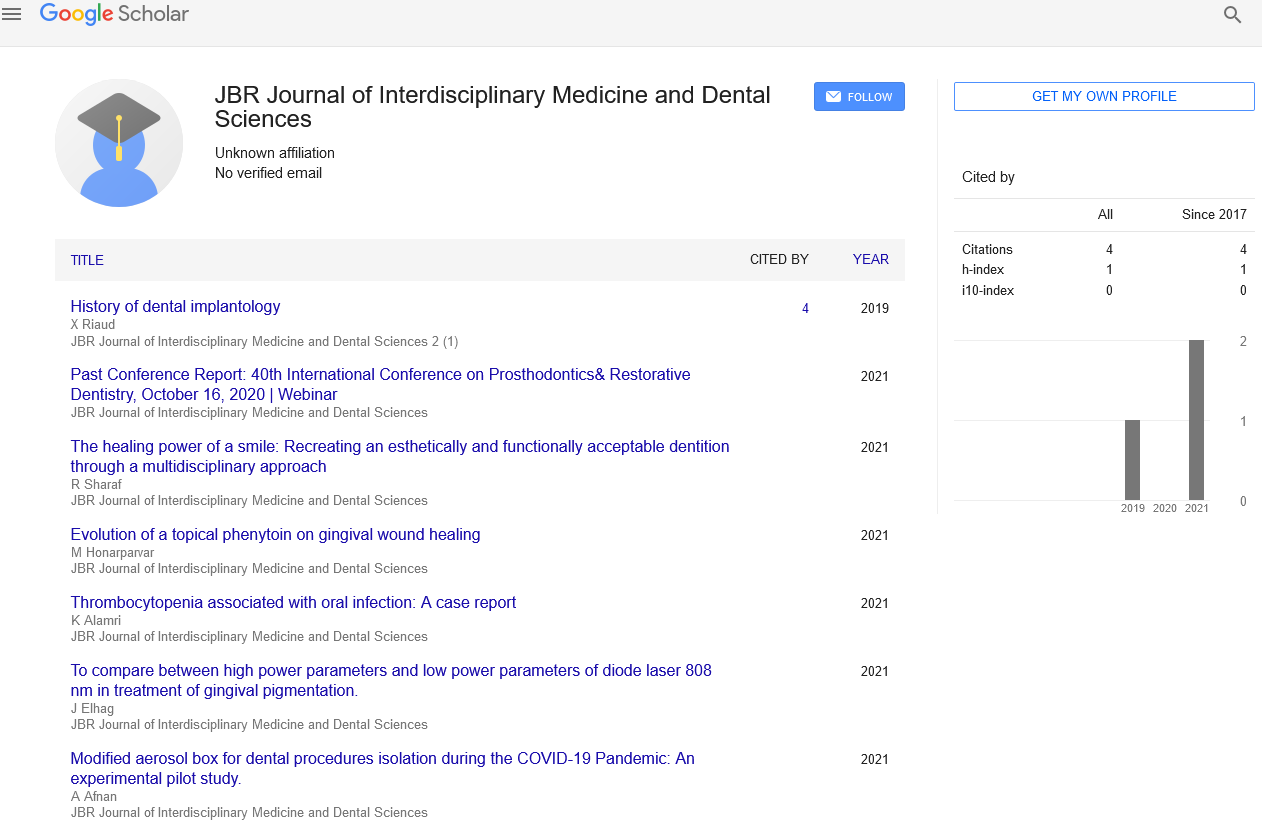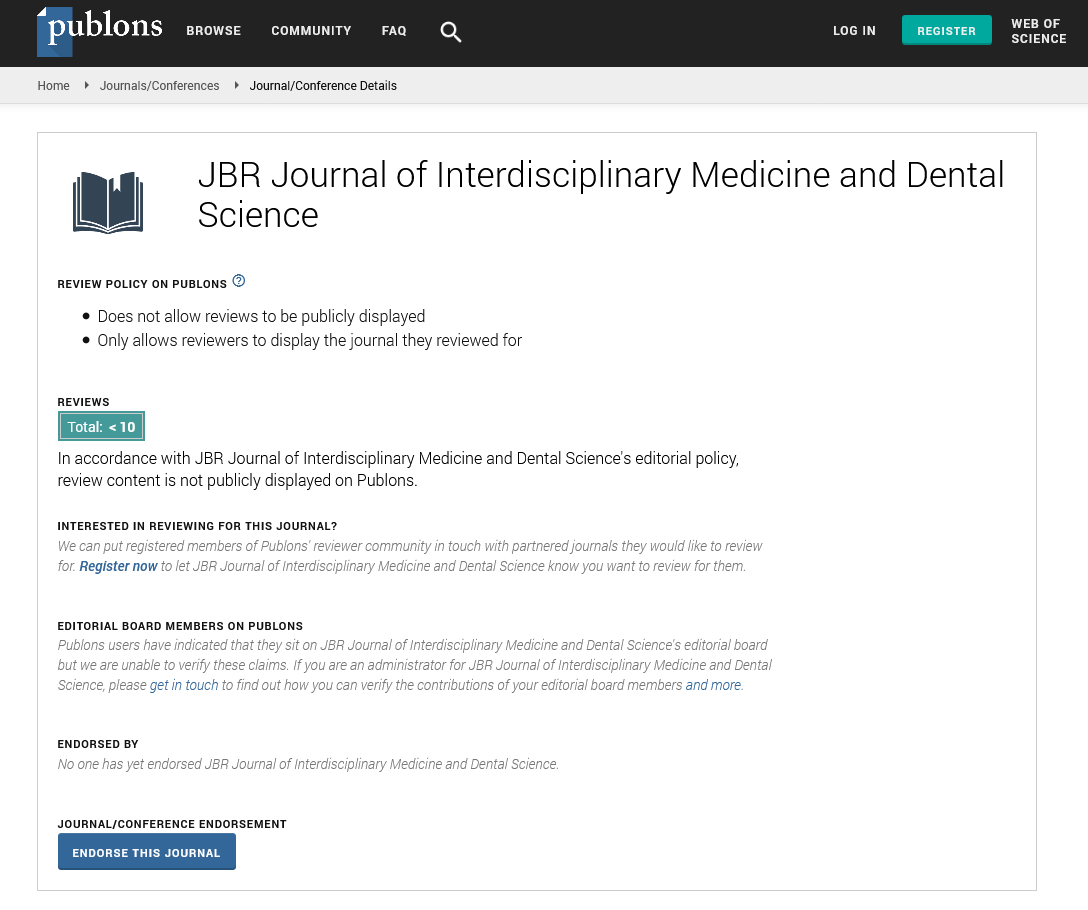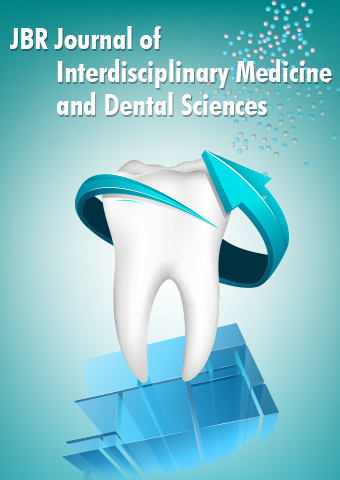Short Communication - JBR Journal of Interdisciplinary Medicine and Dental Sciences (2023) Volume 6, Issue 4
Advancements in Oral Surgery: Innovations Shaping the Future of Dental Care
Govind Sharma*
Department of Dental Pathology, India
Department of Dental Pathology, India
E-mail: sharma_govind14@gmail.com
Received: 1-July-2023, Manuscript No. jimds-23-107860; Editor assigned: 4-July-2023, PreQC No. jimds-23-107860 (PQ); Reviewed: 19-July-2023, QC No. jimds-23-107860; Revised: 24-July-2023, Manuscript No. jimds-23-107860 (R); Published: 31-July-2023, DOI: 10.37532/2376- 032X.2023.6(4).72-74
Abstract
This abstract explores the recent advancements in oral surgery that are redefining the landscape of dental care. Oral surgery, a specialized branch of dentistry, has seen remarkable progress in techniques and technology over the years. The shift towards minimally invasive procedures has resulted in reduced patient discomfort and quicker recovery times. The integration of 3D imaging and guided surgery has enhanced treatment planning and implant placement precision. Laser dentistry has brought forth a new era of precision and efficiency, while regenerative medicine techniques are fostering tissue regeneration and faster healing. Additionally, virtual reality and simulation technologies are transforming dental education and skill development. As technology continues to evolve, the future of oral surgery promises even more remarkable developments, offering patients safer and more efficient treatment options, ultimately improving their oral health and overall well-being.
Keywords
Oral surgery • 3D imaging • Dental education • Oral health • Laser dentistry
Introduction
Oral surgery stands at the forefront of modern dental practice, constantly evolving to meet the growing demands of patient care. Over the years, significant advancements have revolutionized this specialized field, reshaping the way dental professionals approach various oral and maxillofacial conditions. From the adoption of minimally invasive procedures to cutting-edge technologies, oral surgery has witnessed a paradigm shift that ensures better outcomes, enhanced patient experiences, and improved overall oral health. This article delves into the latest innovations in oral surgery, exploring the transformative impact they have had on dental care. We will delve into the integration of 3D imaging and guided surgery, which allows for meticulous treatment planning and precise execution. The advent of laser dentistry has propelled oral surgery into a realm of unparalleled precision and efficiency. Additionally, we will explore the possibilities that regenerative medicine offers, stimulating tissue regeneration and promoting faster recovery after surgical interventions. Furthermore, we’ll discuss the role of virtual reality and simulation in dental education, propelling aspiring oral surgeons to new heights of expertise and proficiency. As we embark on this journey through the advancements in oral surgery, it becomes evident that the future of dental care is brighter than ever, promising improved patient outcomes, reduced discomfort, and a host of novel possibilities for restoring and maintaining oral health [1-5].
Material and Methods
Oral surgery, a specialized branch of dentistry, has evolved significantly over the years, with numerous advancements revolutionizing the field. This article explores the latest innovations in oral surgery that are shaping the future of dental care. From cutting-edge technology to refined techniques, these developments offer patients safer, more efficient, and comfortable treatment options while improving outcomes for a variety of dental conditions.
Minimally invasive procedures
One of the most significant advancements in oral surgery is the transition towards minimally invasive procedures. Traditional surgical approaches often involved extensive incisions and significant trauma to the surrounding tissues. However, with the advent of new techniques and tools, oral surgeons can now perform surgeries with smaller incisions, reducing post-operative pain, swelling, and recovery time. This results in a more positive patient experience and quicker return to normal daily activities.
3D imaging and guided surgery
3D imaging technology has revolutionized the way oral surgeons plan and execute complex dental procedures. Cone-beam computed tomography (CBCT) scans provide detailed and accurate three-dimensional images of the oral and maxillofacial structures. These scans enable surgeons to visualize anatomical features more precisely, leading to better treatment planning and surgical outcomes. Guided surgery, a product of 3D imaging, involves creating a surgical guide based on the patient’s specific anatomy. This guide assists the surgeon in precise implant placement, reducing the margin of error and improving the longevity of dental implants.
Laser dentistry
The integration of laser technology into oral surgery has ushered in a new era of precision and efficiency. Dental lasers are increasingly being used for procedures such as gum disease treatment, removing soft tissue lesions, and even preparing teeth for restorative work. Laser dentistry minimizes bleeding, reduces the need for sutures, and accelerates the healing process, making it an attractive alternative to traditional surgical methods.
Regenerative medicine
Regenerative medicine has shown great promise in the field of oral surgery. Techniques like platelet-rich plasma (PRP) and platelet-rich fibrin (PRF) utilize the patient’s blood components to stimulate tissue regeneration and promote faster healing after surgical procedures. These natural and safe methods aid in bone and soft tissue regeneration, making them valuable tools for implant placement and other reconstructive procedures.
Virtual reality and simulation
Virtual reality (VR) and simulation technologies have made significant strides in dental education and training. Aspiring oral surgeons can now practice complex procedures in a simulated environment, gaining invaluable experience before performing surgeries on actual patients. This technology enhances skill development, confidence, and patient safety by reducing the learning curve for intricate procedures [6-10].
Discussion
The world of oral surgery is continuously evolving, with cutting-edge innovations enhancing patient care and revolutionizing dental treatments. From minimally invasive techniques and 3D imaging to laser dentistry and regenerative medicine, oral surgeons now have a diverse array of tools at their disposal to provide the best possible outcomes for their patients. As technology continues to advance, we can expect even more remarkable developments in oral surgery, further shaping the future of dental care. Patients can look forward to safer, less invasive, and more efficient procedures that improve their oral health and overall well-being. Oral surgery, a specialized branch of dentistry, has evolved significantly over the years, with numerous advancements revolutionizing the field. This article explores the latest innovations in oral surgery that are shaping the future of dental care. From cutting-edge technology to refined techniques, these developments offer patients safer, more efficient, and comfortable treatment options while improving outcomes for a variety of dental conditions.
Conclusion
Patients can look forward to safer, less invasive, and more efficient procedures that improve their oral health and overall well-being. Oral surgery, a specialized branch of dentistry, has evolved significantly over the years, with numerous advancements revolutionizing the field. This article explores the latest innovations in oral surgery that are shaping the future of dental care. From cutting-edge technology to refined techniques, these developments offer patients safer, more efficient, and comfortable treatment options while improving outcomes for a variety of dental conditions.
References
- Phramor L. Validity of claims made in weight management research: a narrative review of dietetic articles. Nutrition Journal. 9, 30 (2010).
- Long Z, Huang L, Lyu J et al. Trends of central obesity and associations with nutrients intake and daily behaviors among women of childbearing age in China. BMC Women's Health. 22, 12 (2022).
- Melina V, Craig W, Levin S et al. Position of the Academy of Nutrition and Dietetics: Vegetarian Diets. J Acad Nutr Diet.116, 1970-1980 (2016).
- Mueller-Stierlin AS, Cornet S, Peisser A et al. Implications of Dietary Intake and Eating Behaviors for People with Serious Mental Illness: A Qualitative Study. Nutrients. 14, 2616 (2022).
- Johnson VR, Washington TB, Chhabria S et al. Food as Medicine for Obesity Treatment and Management. Clinical Therapeutics. 44, 671-681 (2022).
- Partridge L, Deelen J, Slagboom PE et al. Facing up to the global challenges of ageing. Nature. 561, 45-56 (2018).
- Coman V, Vodnar DC. Gut microbiota and old age: Modulating factors and interventions for healthy longevity. Experimental Gerontology. 141, 111095 (2020).
- DeJong EN, Surette MG, Bowdish DM et al. The Gut Microbiota and Unhealthy Aging: Disentangling Cause from Consequence. Cell Host & Microbe. 28, 180-189 (2020).
- Warman DJ, Jia H, Kato H et al. The Potential Roles of Probiotics, Resistant Starch, and Resistant Proteins in Ameliorating Inflammation during Aging (Inflammaging). Nutrients. 14, 747 (2022).
- Fong BY, Chiu WK, Chan WF et al. A Review Study of a Green Diet and Healthy Ageing. Int J Environ Res 18, 8024 (2021).
Indexed at, Google Scholar, Crossref
Indexed at, Google Scholar, Crossref
Indexed at, Google Scholar, Crossref
Indexed at, Google Scholar, Crossref
Indexed at, Google Scholar, Crossref
Indexed at, Google Scholar, Crossref
Indexed at, Google Scholar, Crossref
Indexed at, Google Scholar, Crossref


